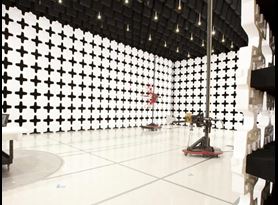Understanding the EMC Directive harmonized standards

James Daniels is the General Manager of Element’s Connected Technologies business in the UK, currently responsible for Operations in our Hull, Skelmersdale, Malvern, Wimborne and Oxford laboratories.
Almost all manufacturers providing electrical and electronic products or components for use in the European Union are required, under CE marking legislation, to comply with EMC Directive 2014/30/EU.
Electromagnetic compatibility (EMC) testing assesses how an electronic device functions when exposed to electromagnetic interference and whether the electromagnetic disturbances produced by the device are within permissible levels.
The importance of following new EMC directive harmonized standards
When seeking to demonstrate compliance with the directive, Element frequently sees a disconnect between the way manufacturers think this can be addressed, and the reality of what must be completed to show due diligence.
From our experience, we estimate that four out of five manufacturers are still approaching the process based on the outdated requirements of the previous EMC Directive. Understanding which directive to comply with and what harmonized standards will support it is critical to obtaining a presumption of conformity.
“4 out of 5 manufacturers are still approaching the process based on the outdated requirements of the previous EMC Directive.”
How to comply with the EMC Directive
The compliance process should always begin with a full risk analysis. Many of the hazards identified in a risk assessment will be covered by applying an appropriate harmonized standard. However, as not all hazards will necessarily be covered, the application of a harmonized standard on its own is not always sufficient for demonstrating compliance with either the EMC Directive or the EMC requirements of the Radio Equipment Directive (RED).
The manufacturer has a duty to select and apply the most appropriate harmonized standard(s) and determine if the standard is fully adequate for the product and its environment or if the product requires additional tests before it can be placed on the market.
The risk assessment enables the manufacturer to marry the risks with the appropriate harmonized standard(s) and establish what additional tests might be necessary for any risks not covered.
Staying up to date with harmonized standards
To ensure the best practice approach, the European Commission’s guide to the EMC Directive 2014/30/EU on the harmonization of the laws of the Member States relating to electromagnetic compatibility can be a useful tool to avoid any ambiguities, particularly regarding additional duties that may not have been required under the previous directive.
The EMC Directive 2014/30/EU was published in the official journal of the European Union. Article 14 of the Directive advises that the manufacturer may choose to restrict the application of the EU-type examination (Annex III) procedure to some aspects of the essential requirements, providing that for other aspects of the essential requirements the Internal Production Control (Annex II) procedure is applied.
Read the latest updates for the EMC Directive 2014 30 eu harmonized standards.
What will mitigate the risk of failure?
If the manufacturer identifies a hazard that is not covered, the next step is to ask what action is necessary to mitigate the risk. This means either looking at other standards for an appropriate test that can be adapted or designing a completely new test suitable for the product. This additional testing can then be recorded in the technical documentation, also called a Technical File, which sits alongside and supports the EU Declaration of Conformity.
It is important to remember that the Directive is non-technical so, in the case of EMC, the essential requirement is that equipment shall be so designed and manufactured, having regard to the state of the art, to ensure that:
a) the electromagnetic disturbance generated does not exceed the level above which radio and telecommunications equipment or other equipment cannot operate as intended.
b) it has a level of immunity to the electromagnetic disturbance to be expected in its intended use, allowing it to operate without unacceptable degradation of its intended use.
Combine harmonized standards with risk assessment
Harmonized standards are a convenient way to support risk reduction, but it is possible to comply with a harmonized standard and still fail to meet the essential requirements of the Directive.
A large amount of flexibility and autonomy is given to the manufacturer, including the ability to use their own tests to demonstrate compliance, which means a thorough EMC risk assessment is essential.
Manufacturers need to fully review and understand the product’s intended operating environment, considering both the end-user performance requirements and the electromagnetic environment to determine the appropriate tests and limits.
Only by assessing these factors is it possible to identify the right tests to ensure the product is fit for purpose.
“Standards can often incorporate compromises, and the application of harmonized standards may not allow for climatic influences or degradation of the product over its entire service life. Gaps can also exist when applying standards regarding the frequency ranges they cover. For these reasons, an EMC risk assessment is invaluable in supporting your approach to EMC testing and assessment, and your conformity declaration.”
James Daniels
GENERAL Manager, Connected TECHNOLOGIES
Consider the potential use and misuse of the product
When evaluating the intended EMC environment, it is essential to consider the potential use and the potential misuse of the product. For example, harmonized standards usually assume an electromagnetic environment, such as household, industrial, or medical.
It may be assumed, for example, that a laptop is going to be used in a home or office environment. However, if the end-user decides to use it somewhere else (for example, on a train) or in a different way than intended (such as a diagnostic tool in a factory setting) then the EMC environment will be very different and supplementary or increased levels of testing should be considered.
- What might the product interfere with?
- What might interfere with the product?
Tests that will answer these questions are often carried out in-house at other stages of the design and manufacturing process. Still, it is vital that the manufacturer understands how to apply and use these tests to comply with the Directive, seeking expert help if necessary.
Additional EU product directives
It is also critical to consider what other non-EMC testing and European standards might be necessary. Remember, the Directive is about functionality. It does not assess safety, including electromagnetic safety. This is covered by other CE Marking directives such as the Low Voltage Directive (LVD), Machinery Safety, and Medical Devices directives.
Adding wireless functionality to a product will add a further dimension to the testing process, as the product is now officially considered ‘radio equipment’ and must be treated accordingly. Compliance needs to be demonstrated to the Radio Equipment Directive (RED) rather than the EMC Directive 2014/30/EU, with radio standards taking precedence and making testing more complex.
Benefit from early consideration of EMC directive harmonized standards
The most cost-effective approach to EMI EMC testing and certification is always to consider testing to EMC Directive 2014/30/EU as early as possible in the development cycle.
Additionally, combining the tests into a single program can also provide significant benefits to the manufacturer, reducing time and cost and enabling the product to reach the market more rapidly.
Our experts are here to help
Element can help design a test suite to include a combination of directives or other industry-specified tests. In addition to legislative testing, manufacturers frequently need to comply with additional contractual EMC testing by the automotive, defense, and aerospace industries. Our EMC technical experts a wide range of industry-specific specifications.
If you would like to learn more about Electromagnetic Compatibility (EMC) testing requirements, please contact our experts today.
Find related Resources
Get white papers, updates and event invites
Subscribe to content updates
Related Services

EMC Testing Services
Find out how Element delivers electromagnetic compatibility testing (EMC) solutions to RTCA/DO-160, MIL-STD-461 and Def-Stan 59-411 standards.

Commercial EMC Testing
At Element, we test thousands of products every year, having one of the largest capacities for electromagnetic (EMC) testing of commercial and industrial electronic devices.

Automotive EMC Testing
Element’s automotive EMC testing services ensure the safety and compatibility of your electric components, systems and sub-assemblies.

Medical Device EMC Testing
Element is the ideal partner for EMC testing, safety, certification and global approvals of your Class I, II and III electronic medical devices.

